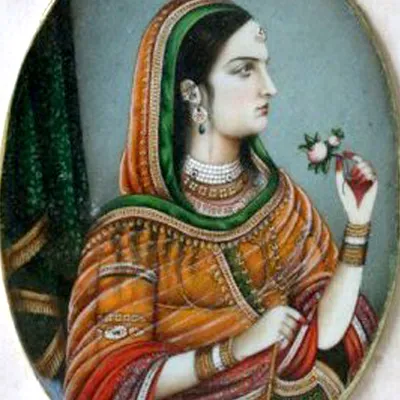[HerStory Flashback] Gulbadan Banu Begum
The list of court chroniclers, who have penned the history of the Mughals, has some very well known names such as Khafi Khan and Abul Fazl. These chroniclers and others of the age aimed to be authoritative histories in the manner of generic histories of rulers, writes historian Ruby Lal.

In this list of chroniclers one name stands alone, that of Gulbadan Banu Begum whose work Humayun Nama is a different kind of history. Gulbadan Banu Begum was born in 1523 in Kabul. She was the daughter of Babur and Dildar Begum. Also the sister of Humayun and aunt of Akbar, she had travelled to Agra at the age of six and a half in 1529.
She had been witness to the early Mughal rulers –Babur and Humayun and was to see Akbar’s reign too.
According to Ruby Lal, Gulbadan moved away from the genre of tarikh to produce an account of far more ‘modest’ incidents in the lives of Babur and Humayun. Her account of the everyday lives of this royal family in peripatetic circumstances is a unique piece of writing.”
Gulbadan’s writing was from experience, she had witnessed the early turmoil that marked Babur and Humayun’s reign.
She moved with the household time and again, a party to the events — birth, death, war, battles etc. at the court and the events and daily lives that the Mughal harem witnessed. Married to a Chaghatai Mughal, Khizr Khvajeh Khan, no details of her marriage has been found in her text.
She spent her childhood under her father’s rule in Kabul and Hindustan: her girlhood and young wifehood shared the fall and exile of Humayun; and her maturity and failing years slipped past under the protection of Akbar, writes Annette S. Beveridge who has translated the Humayun Nama.
Ruby Lal states that Gulbadan Banu Begum was thus witness to the processes and mechanisms of a

monarchy in the making, seeing it through many vicissitudes from the inception of the Mughal kingdom from the early conquests of Babur to its established splendour during Akbar’s reign. She as well as Khizr Khvajeh Khan seems to have spent much of their time wandering with what may be described as her peripatetic Mughal family home.She came to write the Humayun Nama at the behest of her nephew, Emperor Akbar.
Her account begins with:
In the name of God, the Merciful, the Compassionate!
There had been an order issued, ‘write down whatever you know of the doings of Firdaus-makhani and Janat-ashyani.’
Ruby Lal’s reading of Gulbadan Begum is interesting – she points that Gulbadan brings to light things like — questions of correct deportment in the preparation of gifts and the manner of presenting (and accepting) them-so central to the sensibilities of the Timurid-Mughal world. Why this is important is because it points out to the centrality and the hierarchal character of these relationships based on what Babur allotted or gifted to whom.
These are something other historians writing about the time were most likely to miss.
According to Ruby Lal, “Gulbadan creates an unusual space in her writing, and helps to compose a different picture of many areas of Mughal life about which we know very little from other sources. This is interestingly, the genre title that Gulbadan chose was different from all of these: it was Ahval, a word meaning conditions, state, circumstances, or situations.”
For example Gulbadan recounts in Humayun Nama–
Upto the time of our reaching Laghman, neither the royal tents nor the pavilions of the begams had arrived, but the mihr-amez tent had come. We all, his Majesty and all of us, and Hamida-banu Begam sat in that tent till three hours past midnight and then went to sleep where we were, in company with that altar of truth (Humayun).
Early next morning he wished to go and see the riwaj on the Koh. The begams’ horses were in the village, so the starting-time passed before they came up. The emperor ordered that the horses of everyone who was outside should be brought. When they came he gave the order: ‘Mount.’
Bega Begam and Mah-chuckak begum were still putting on their head- to–foot dresses, and I said to the Emperor- ‘If you think well, I will go and fetch them.’ ‘Go,’ he answered, ‘and bring them quickly.’ I said to the begams and to Mah- chuchak Begam and the rest of the ladies: I have become the slave of his Majesty’s wishes. What trouble waiting gives!” I was gathering them all together and bringing them when he came to meet me and said: ‘Gul-badan! the proper hour for starting has gone by. It would be hot the whole way. God willing, we will go after offering the afternoon prayer.’ He seated himself in a tent with Hamida- banu Begam. After afternoon prayers there was the interval between two prayers before the horses arrived. In this interval he went away.
Not only is Gulbadan Begams’ work interesting, it is also our window into the lives of the Mughal emperors, relationship between family members etc.
It is also a testimony to Gulbandan’s capability to come up with a history that is different and yet insightful. As Ruby Lal points out, for Gulbadan to write a memoir of the times suggests she was recognised to be ‘learned’; and that a Persian verse which is attributed to her is further testimony to her standing in this respect.
Reference-
The History of Humayun:Humayun-Nama by Gul-Badan Begam, Trans. by Annette S. Beveridge, LLP, New Delhi, 1902
Historicizing the Harem: The Challenge of a Princess’s Memoir by Ruby Lal, Feminist Studies, Vol. 30, No. 3 (Fall, 2004), pp. 590-616


![[HerStory Flashback] Gulbadan Banu Begum](https://images.yourstory.com/cs/wordpress/2015/08/yourstory-herstory-Flash-Back-gulbadan-begum.jpg?mode=crop&crop=faces&ar=2%3A1&format=auto&w=1920&q=75)




